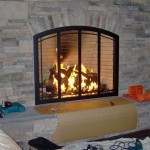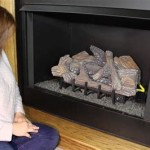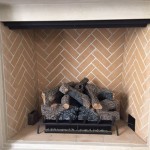Adding A Mantel To A Stone Fireplace
A stone fireplace, a focal point of many homes, exudes rustic charm and enduring elegance. While its inherent beauty is undeniable, the addition of a mantel can significantly enhance its aesthetic appeal and functionality. A mantel provides a surface for decorative displays, a functional shelf, and a framing element that subtly draws the eye. Choosing and installing a mantel on a stone fireplace, however, requires careful consideration of several factors, including the fireplace's design, the stone type, and proper installation techniques.
The process of adding a mantel to a stone fireplace involves preparing the surface, selecting an appropriate mantel material and style, and securely attaching the mantel to the stone. This article will explore each of these aspects in detail, offering guidance on how to successfully integrate a mantel that complements the fireplace's existing features and enhances the overall ambiance of the room.
Evaluating the Stone Fireplace
Before embarking on the mantel installation, a thorough assessment of the stone fireplace is crucial. This evaluation involves examining the stone type, the fireplace's overall design, and any existing structural features that may influence the mantel's placement and attachment. The type of stone used in the fireplace construction will dictate the appropriate drilling and anchoring techniques required for a secure installation. Some stones are softer and more porous, requiring specialized drill bits and anchors, while others are harder and more resistant, necessitating more robust tools and hardware.
The fireplace's design, whether it is a traditional stacked stone configuration or a more contemporary arrangement, will influence the size, style, and positioning of the mantel. A grand, imposing fireplace may accommodate a larger, more ornate mantel, while a smaller, more minimalist design might call for a simpler, more understated mantel. Consider the existing architectural style of the room and the overall aesthetic you wish to achieve when selecting the mantel design.
Finally, examine the structural integrity of the stone itself. Look for any loose or cracked stones that may compromise the stability of the mantel. Repairing or replacing any damaged stones before installation is essential to ensure a safe and lasting result. If the stone is particularly irregular or uneven, you may need to create a level surface for the mantel to rest upon, using shims or additional stone to compensate for any imperfections.
Selecting the Mantel Material and Style
The choice of mantel material and style is a critical decision that will significantly impact the fireplace's overall appearance. A variety of materials, including wood, stone, and metal, can be used to construct a mantel, each offering its own unique aesthetic and functional properties. Wood mantels are a popular choice, offering a classic and versatile look that can be customized with various stains, paints, and finishes. Stone mantels, often made from materials such as granite, marble, or limestone, provide a seamless and elegant integration with the stone fireplace. Metal mantels, typically crafted from materials such as wrought iron or steel, offer a more contemporary and industrial aesthetic.
When selecting the mantel material, consider the existing stone type and the desired style. A rustic stone fireplace might benefit from a reclaimed wood mantel, adding to its natural charm. A more refined stone fireplace could be complemented by a sleek marble mantel, enhancing its sophisticated appeal. The material's texture and color should also be carefully considered to ensure a harmonious blend with the surrounding stone.
The style of the mantel should also be carefully considered in relation to the overall aesthetic of the room and the fireplace itself. A traditional fireplace may call for a more ornate mantel with intricate carvings and moldings, while a modern fireplace might benefit from a simpler, more minimalist design with clean lines and a smooth surface. The mantel's size and proportions should also be carefully considered to ensure that it is appropriately scaled to the fireplace and the room. A mantel that is too large can overwhelm the fireplace, while a mantel that is too small can appear insignificant.
Installing the Mantel: A Step-by-Step Guide
The installation of a mantel on a stone fireplace requires precision and attention to detail. Prior to installation, gather all necessary tools and materials, including a drill with masonry bits, anchors suitable for the specific stone type, a level, a measuring tape, a pencil, and appropriate safety gear, such as safety glasses and gloves.
The first step involves determining the desired height and placement of the mantel. A general rule of thumb is to position the mantel approximately 12 inches above the fireplace opening, but this can vary depending on the size and design of the fireplace and the room. Use a level and measuring tape to accurately mark the desired location of the mantel on the stone.
Next, carefully drill pilot holes into the stone at the marked locations. Use a masonry drill bit that is slightly smaller than the diameter of the anchors you will be using. Begin drilling slowly and steadily, applying consistent pressure to avoid cracking or damaging the stone. Once the pilot holes are drilled, insert the anchors into the holes. The type of anchors used will depend on the stone type and the weight of the mantel. Wedge anchors, sleeve anchors, and chemical anchors are all viable options.
With the anchors securely in place, carefully position the mantel against the stone, aligning it with the anchors. Ensure that the mantel is level before securing it to the wall. Depending on the mantel design and the type of anchors used, you may need to use screws or bolts to attach the mantel to the anchors. Tighten the screws or bolts until the mantel is securely fastened to the stone. Avoid overtightening, as this could damage the stone or the mantel.
After the mantel is securely installed, inspect the installation to ensure that it is level, stable, and aesthetically pleasing. If necessary, you can use shims or decorative trim to conceal any gaps or imperfections. Finally, clean the surrounding area and dispose of any debris.
The process of adding a mantel to a stone fireplace requires a careful approach, taking into consideration the unique characteristics of the stone, the design of the fireplace, and the desired aesthetic. By carefully evaluating these factors and following the steps outlined above, you can successfully integrate a mantel that enhances the beauty and functionality of your stone fireplace.
Securing the Mantel: Anchoring Techniques
The method used to secure the mantel to the stone fireplace is paramount to its longevity and safety. Utilizing the correct anchoring technique is critical to preventing the mantel from detaching or becoming unstable over time. The optimal anchoring method depends on the type of stone, the weight of the mantel, and the overall design of the fireplace.
For lighter mantels, expanding wedge anchors might suffice. These anchors are inserted into pre-drilled holes and then tightened, causing them to expand and grip the stone. They are relatively easy to install and provide a secure hold for smaller mantels. However, for heavier mantels, more robust anchoring solutions are necessary.
Sleeve anchors offer increased strength and durability compared to wedge anchors. They consist of a sleeve that expands as a bolt is tightened, providing a firm grip against the surrounding stone. Sleeve anchors are suitable for a wider range of mantel weights and stone types, making them a versatile option.
For particularly heavy mantels or when working with softer or more fragile stone, chemical anchors provide the most secure and reliable attachment. Chemical anchors involve injecting a resin adhesive into pre-drilled holes, then inserting threaded rods or bolts into the adhesive. The resin hardens and creates a strong bond between the stone and the anchor. This method minimizes stress on the stone and provides exceptional holding power.
Regardless of the anchoring technique used, it is crucial to select anchors that are specifically designed for masonry applications and that are rated to support the weight of the mantel. Following the manufacturer's instructions carefully is essential to ensure proper installation and maximum holding capacity.
Addressing Stone Irregularities
Stone fireplaces often exhibit natural irregularities, such as uneven surfaces, protruding stones, and variations in texture. These irregularities can pose challenges when installing a mantel, as they can prevent the mantel from sitting flush against the stone and compromise its stability. Addressing these irregularities is crucial to achieving a professional and secure installation.
One common technique for dealing with uneven surfaces is to use shims. Shims are thin pieces of wood or plastic that are inserted between the mantel and the stone to create a level surface. They can be carefully positioned and adjusted to compensate for any variations in the stone's surface. Once the mantel is level, the shims can be concealed with trim or caulk.
For protruding stones, it may be necessary to carefully chip away or grind down the offending stones to create a more even surface. This should be done with caution, as excessive force can damage the surrounding stone. Using specialized tools, such as a masonry chisel or a diamond grinding wheel, can help to remove the excess stone without causing further damage. Always wear appropriate safety gear, including safety glasses and a dust mask, when working with stone.
Another approach is to customize the mantel to fit the specific contours of the stone fireplace. This may involve creating a custom-shaped mantel that conforms to the irregularities of the stone or adding decorative trim that conceals any gaps or imperfections. A skilled carpenter or stonemason can assist with this process, ensuring that the mantel is seamlessly integrated with the stone fireplace.
Maintaining the Mantel and Fireplace Surround
Once the mantel is successfully installed, ongoing maintenance is essential to preserve its appearance and structural integrity. Regular cleaning and occasional repairs can help to ensure that the mantel remains a beautiful and functional addition to the fireplace for years to come.
The cleaning method will depend on the mantel material. Wood mantels can be cleaned with a damp cloth and mild soap to remove dust and dirt. Avoid using harsh chemicals or abrasive cleaners, as these can damage the finish. Stone mantels can be cleaned with a stone cleaner or a solution of water and vinegar. Metal mantels can be cleaned with a metal cleaner or a damp cloth.
Inspect the mantel regularly for any signs of damage, such as cracks, chips, or loose fasteners. Repair any damage promptly to prevent it from worsening. Cracks in wood mantels can be filled with wood filler and sanded smooth. Chips in stone mantels can be repaired with a stone repair kit. Loose fasteners should be tightened or replaced as needed.
The stone fireplace surround should also be regularly inspected and maintained. Remove any soot or creosote buildup with a fireplace brush or a specialized cleaning solution. Repair any cracks or damage to the stone to prevent further deterioration. Applying a sealant to the stone can help to protect it from moisture and stains.
By following these maintenance tips, you can ensure that your mantel and stone fireplace remain a beautiful and functional focal point in your home for many years.

How To Build And Hang A Mantel On Stone Fireplace Shanty 2 Chic

Fireplace Mantel Installation Before And After

How To Build And Hang A Mantel On Stone Fireplace Shanty 2 Chic

Eldorado Stone Fireplace Installation With Mantel Time Lapse Installing Veneer

Fireplace Mantel Installation Before And After

Diy Faux Cast Stone Fireplace Part 2 Building The Mantel Top Shelf

How To Install A Floating Mantle The Easy Way In Just One Afternoon

Country Style Mantels And Fireplaces Town Living

Custom Built Fireplace Surround Install A New Mantel Hearth

Stone Fireplace Makeover Taryn Whiteaker Designs








